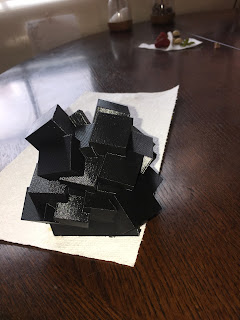From VR to 3D printing with Google Blocks
Oculus Rift + Google Blocks + 3D Printer
Workflow
There was some discussion that Google Blocks, which is sort of a 3d MacPaint if you will (or if you understand me, if you remember that far back, etc.) is not suitable for generating files to 3d Print. In fact, it is relatively trivial.
Once you click the save icon in your scene, a folder with a randomly generated name will be created in the Blocks directory in your Documents directory. Inside that folder you will find two files named Model ... one is a .gltf file and the other is a .obj file.
I use Slic3r to prepare 3d objects for printing, and have usually used .stl files (from OpenScad, not that it matters) but Slic3r is perfectly happy to open a .obj file as well.
I have only printed a couple of objects, but I can verify that it is doable. If you are interested in trying it yourself, I will only make a couple of suggestions. For the base of your object, if you want one, it is best to use the grid option in Blocks to be sure that the object you choose (I used a cube to start, then tweaked it to suit) is oriented such that it can be made to sit flat. In Slic3r I found it necessary to do a 90º rotation around the X axis, after importing the object.
You may also find that the object starts out super tiny, and you need to enlarge it quite a bit before printing. I have an object that looked reasonably large in the Virtual world, but I needed to enlarge it 30,000% and it still printed out small enough for me to hold in my hand and enclose in my fist (not comfortably though, there are a lot of corners from the cubes I built it with). It was so tiny to start with that I could not see the grid that Slic3r generates to orient you. The grid lines were further apart than the size of my screen ...
Why should I care?
I thought it was pretty cool, but maybe you feel differently? Putting on a headset, entering a virtual world, using tracking devices in your hands to select and manipulate virtual tools, tools that enable you to construct complex shapes ... all that is cool enough. However, to then take off the headset, run a few more tools, set up your printer, and in a few hours (or several hours, depending of course on the size of the model) you will have a real thing that is a pretty close copy of what you built virtually. It certainly feels more like living in the 21st century than a lot of other things I do every day.
A small gripe
It bothers me a bit, as a certified Apple Fan Boy (though a somewhat disgruntled one), that I have to use hardware from Facebook (they bough Oculus of course), and software from Google, running on a Microsoft Operating system to do this. I do run Slic3r on my MacBook Air (it sits near the the 3d printer, and the built in SD card reader is convenient) but it does seem Apple has some catching up to do, at least in this arena.


